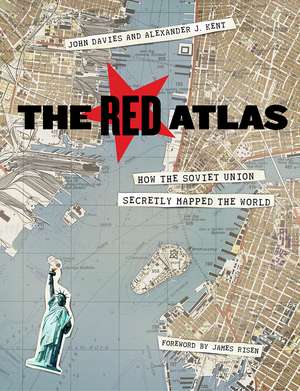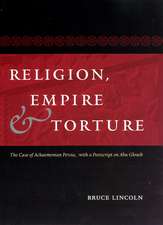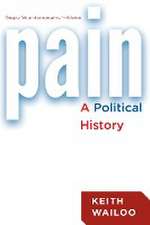The Red Atlas: How the Soviet Union Secretly Mapped the World
Autor John Davies, Alexander J. Kent Cuvânt înainte de James Risenen Limba Engleză Hardback – 17 oct 2017
Nearly thirty years after the end of the Cold War, its legacy and the accompanying Russian-American tension continues to loom large. Russia’s access to detailed information on the United States and its allies may not seem so shocking in this day of data clouds and leaks, but long before we had satellite imagery of any neighborhood at a finger’s reach, the amount the Soviet government knew about your family’s city, street, and even your home would astonish you. Revealing how this was possible, The Red Atlas is the never-before-told story of the most comprehensive mapping endeavor in history and the surprising maps that resulted.
From 1950 to 1990, the Soviet Army conducted a global topographic mapping program, creating large-scale maps for much of the world that included a diversity of detail that would have supported a full range of military planning. For big cities like New York, DC, and London to towns like Pontiac, MI and Galveston, TX, the Soviets gathered enough information to create street-level maps. What they chose to include on these maps can seem obvious like locations of factories and ports, or more surprising, such as building heights, road widths, and bridge capacities. Some of the detail suggests early satellite technology, while other specifics, like detailed depictions of depths and channels around rivers and harbors, could only have been gained by actual Soviet feet on the ground. The Red Atlas includes over 350 extracts from these incredible Cold War maps, exploring their provenance and cartographic techniques as well as what they can tell us about their makers and the Soviet initiatives that were going on all around us.
A fantastic historical document of an era that sometimes seems less distant, The Red Atlas offers an uncanny view of the world through the eyes of Soviet strategists and spies.
From 1950 to 1990, the Soviet Army conducted a global topographic mapping program, creating large-scale maps for much of the world that included a diversity of detail that would have supported a full range of military planning. For big cities like New York, DC, and London to towns like Pontiac, MI and Galveston, TX, the Soviets gathered enough information to create street-level maps. What they chose to include on these maps can seem obvious like locations of factories and ports, or more surprising, such as building heights, road widths, and bridge capacities. Some of the detail suggests early satellite technology, while other specifics, like detailed depictions of depths and channels around rivers and harbors, could only have been gained by actual Soviet feet on the ground. The Red Atlas includes over 350 extracts from these incredible Cold War maps, exploring their provenance and cartographic techniques as well as what they can tell us about their makers and the Soviet initiatives that were going on all around us.
A fantastic historical document of an era that sometimes seems less distant, The Red Atlas offers an uncanny view of the world through the eyes of Soviet strategists and spies.
Preț: 229.65 lei
Nou
Puncte Express: 344
Preț estimativ în valută:
43.94€ • 46.00$ • 36.36£
43.94€ • 46.00$ • 36.36£
Carte disponibilă
Livrare economică 15-29 martie
Livrare express 01-07 martie pentru 73.81 lei
Preluare comenzi: 021 569.72.76
Specificații
ISBN-13: 9780226389578
ISBN-10: 022638957X
Pagini: 272
Ilustrații: 282 color plates
Dimensiuni: 178 x 229 x 30 mm
Greutate: 0.78 kg
Ediția:1
Editura: University of Chicago Press
Colecția University of Chicago Press
ISBN-10: 022638957X
Pagini: 272
Ilustrații: 282 color plates
Dimensiuni: 178 x 229 x 30 mm
Greutate: 0.78 kg
Ediția:1
Editura: University of Chicago Press
Colecția University of Chicago Press
Notă biografică
John Davies is editor of Sheetlines, the journal of the Charles Close Society for the Study of Ordnance Survey Maps. He lives in London. Alexander J. Kent is a reader in cartography and geographical information science at Canterbury Christ Church University and president of the British Cartographic Society.
Cuprins
Foreword by James Risen
Note to Readers
Introduction
Why this book is a detective story
1 War and Peace
The background of the story—from Napoleon’s march on Moscow to the collapse of the Soviet Union
2 Capturing the World—on Paper
Describing the style, content, and symbology of the Red Army’s maps of the world
3 Plots and Plans
The overt and covert methods of the Soviet cartographers
4 Resurrection
The discovery of the maps after the fall of the Soviet Union and their continuing significance today
Acknowledgments
Appendix 1 Examples of Maps of Various Series and Scales
Appendix 2 References and Resources
Appendix 3 Translation of Typical City Plan Spravka
Appendix 4 Translation of Typical Topographic Map Spravka
Appendix 5 Symbols and Annotation
Appendix 6 Glossary of Common Terms and Abbreviations
Appendix 7 Print Codes
Appendix 8 Secrecy and Control
General Index
Place-Names Index
Note to Readers
Introduction
Why this book is a detective story
1 War and Peace
The background of the story—from Napoleon’s march on Moscow to the collapse of the Soviet Union
2 Capturing the World—on Paper
Describing the style, content, and symbology of the Red Army’s maps of the world
3 Plots and Plans
The overt and covert methods of the Soviet cartographers
4 Resurrection
The discovery of the maps after the fall of the Soviet Union and their continuing significance today
Acknowledgments
Appendix 1 Examples of Maps of Various Series and Scales
Appendix 2 References and Resources
Appendix 3 Translation of Typical City Plan Spravka
Appendix 4 Translation of Typical Topographic Map Spravka
Appendix 5 Symbols and Annotation
Appendix 6 Glossary of Common Terms and Abbreviations
Appendix 7 Print Codes
Appendix 8 Secrecy and Control
General Index
Place-Names Index
Recenzii
“During the Cold War, the Soviet military undertook a secret mapping program that’s only recently come to light in the West. Military cartographers created hundreds of thousands of maps and filled them with detailed notes on the terrain and infrastructure of every place on Earth. It was one of the greatest mapping endeavors the world has ever seen. . . . Much of what’s known about this secret Soviet military project is outlined in The Red Atlas."
“When money and technology weren’t an issue—when it was just about brainpower and hard work—the Soviets could compete with anyone. So it shouldn’t be a surprise to learn that their mapmakers, like their athletes, were among the best in the world. Many of the maps in this collection were made to guide Soviet soldiers in potential wars against enemies abroad. But like the best socialist-realist propaganda posters, they transcend their original purpose. Decades after they were created, they are now unique works of art, offering the viewer what can only be called a kind of emotional-cartographic-political experience.”
"Fascinating. . . . Lavishly illustrated. . . . If this book merely offered a newly acquired selection of cartographic items, it would still be worth buying and reading. . . . The maps themselves are attractive, and the supporting technical and scholarly apparatus will be helpful to general readers as well as specialists. . . . The true value, however, lies in the careful examination and side-by-side comparison of the Soviet maps with their Western (mostly American and British) counterparts."
"For anyone interested in maps, this book is a sheer delight. It also carries huge educational and historical value by introducing the inner workings of the Soviet military topography--a little-known and rather fascinating side of the Cold War in its own right."
"The Red Atlas is an amazing book, especially if you’ve ever pondered the power of satellite imagery as a surveillance tool. Military mapping has two modes: mapping one’s own territory so you can better defend it, and mapping an opponent’s territory so you can attack or take control. Focusing on the latter, The Red Atlas shows the impressive and frightening detail of maps of Western Europe and North American prepared by Soviet cartographers during the Cold War. Overhead imaging with satellites and high-resolution cameras provided the basic geographic canvass and ground intelligence--spies, tourists, and maps sold freely by commercial firms and government surveys--filled in local details such as street names, the height and width of railway overpasses, and the load capacity of bridges. Map collector John Davies collaborated with academic cartographer Alex Kent to tell the story of how the USSR systematically mapped the West’s cities, ports, highways, railways, and military targets, and how these maps fell into the hands of map dealers following the collapse of the Soviet Union. Their examination of selected examples from Britain and the United States also highlights errors that are revealing in some cases and puzzling in others. The Red Atlas belongs in the collection of every map enthusiast and military historian--carefully researched, well-written, and exquisitely designed and printed, it’s perhaps the only recent map history that can be called a real eye-opener.”
“Utterly fascinating. A must-read for anyone interested in the former Soviet Union or in maps and mapping in general.”
"...this book is not only an original contribution to the study of cartography but also gives a fascinating insight into a little-studied aspect of Cold War history. It should appeal to a broad spectrum of readers well beyond the category of ‘map enthusiasts’."








